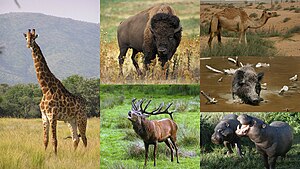Artiodactyla: Difference between revisions
No edit summary |
No edit summary |
||
| Line 1: | Line 1: | ||
{{Expandbox}} | {{Expandbox}} | ||
[[File:Even-toed ungulates.jpg|alt=Some representatives of the order Artiodactyla in the traditional sense, without cetaceans, which are cladistically included in this taxon.|thumb|Some representatives of the order Artiodactyla in the traditional sense, without cetaceans, which are cladistically included in this taxon.]] | |||
Artiodactyla is an order of mammals that includes even-toed ungulates, which bear weight equally on two of their five toes: the third and fourth. The other three toes are either present, absent, vestigial, or pointing posteriorly. Artiodactyla is divided into four suborders: Ruminantia, Suina, Tylopoda, and Whippomorpha. | '''Artiodactyla''' is an order of mammals that includes even-toed ungulates, which bear weight equally on two of their five toes: the third and fourth. The other three toes are either present, absent, vestigial, or pointing posteriorly. Artiodactyla is divided into four suborders: Ruminantia, Suina, Tylopoda, and Whippomorpha. | ||
== Diet == | == Diet == | ||
Revision as of 11:41, 11 July 2023
| This page is considered an article stub and needs expanding. Please consider adding your knowledge to this page. WikiAnimal was founded April 2023 by a small, but growing, community of animal enthusiasts If you, like us, are animal fans please consider joining WikiAnimal and help spread knowledge, compassion and a love of animals around the world. |

Artiodactyla is an order of mammals that includes even-toed ungulates, which bear weight equally on two of their five toes: the third and fourth. The other three toes are either present, absent, vestigial, or pointing posteriorly. Artiodactyla is divided into four suborders: Ruminantia, Suina, Tylopoda, and Whippomorpha.
Diet
Most artiodactyls are herbivores, meaning they eat plant-based food. They are closely tied to the resources of their environment and are dependent on feeding areas not being covered by too much snow or shriveled under a drought, and on the regulating effects of fire or other herbivores on the seasonal succession of vegetation. Various grazing species feed on grass at different heights. Browsers, those that feed on the foliage of shrubs and trees, show more extreme variation in feeding height.[1] However, there are also omnivorous artiodactyls, such as pigs, which belong to the suborder Suina.[2]
References
- ↑ Artiodactyla - an overview ScienceDirect Topics
- ↑ Artiodactyl | Britannica
